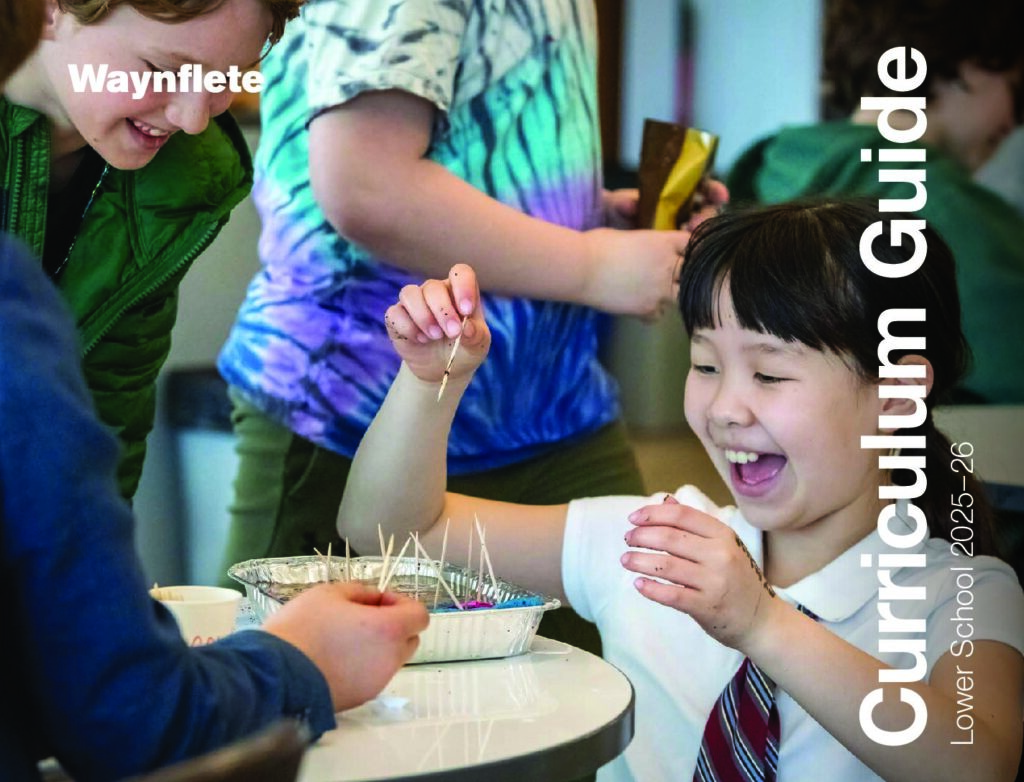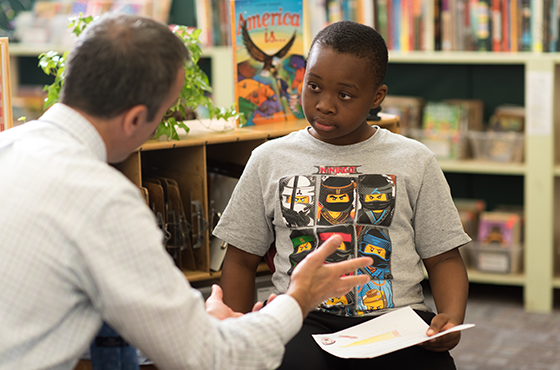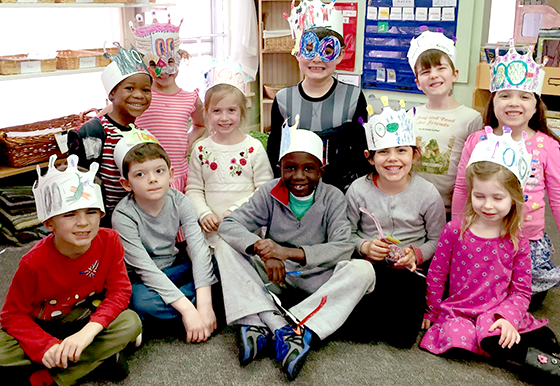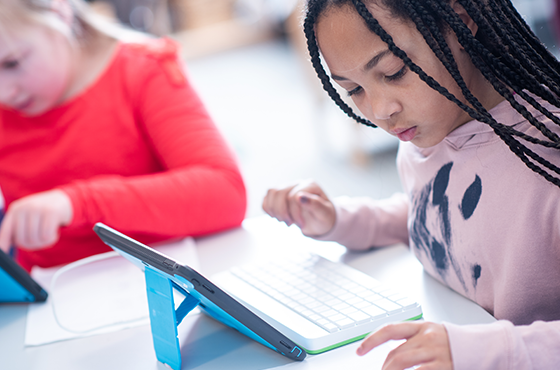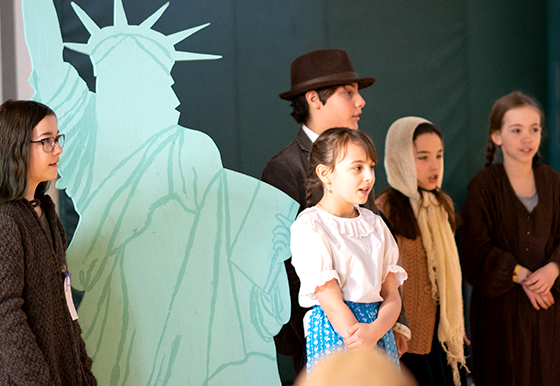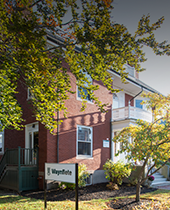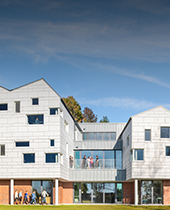
Lower School
Program
In Waynflete classes, students start to solve new problems by asking themselves two questions: What do I notice? What do I wonder?
Our dedicated teachers know there are many ways to arrive at a right answer and that students learn best when they find and follow their own path. That’s why we encourage the keen observations, creative leaps, hands-on experimentation, and rigorous thinking that lead to inventive solutions and rich insights—and make active learners for life.
Kindergarten – Grade 1 Language Arts
The primary goals of our K–1 program are for children to develop self-confidence, a love for learning, and a respect and appreciation for themselves, others, and their environment. We emphasize the development of both academic and social skills and encourage children to cooperate with each other, make choices, and take responsibility for their own learning. The curriculum is designed to accommodate the wide range of learning styles and skill levels that children bring to the classroom. Diverse learning opportunities are presented in a supportive, stimulating, and creative experiential setting. Individual, small-group, and whole-class activities are employed throughout the day.
Listening
- enjoy stories, poetry, rhyming, and playing with sounds of language,
- listen and respond appropriately to others,
- follow multistep directions,
- match letters to sounds, and
- hear and remember stories and other information.
Speaking
- exhibit ability to verbalize needs,
- recite chants and poetry with the group,
- share ideas and experiences,
- dictate stories with a beginning, middle, and end,
- join discussions with relevant comments, and
- discuss stories with attention to sequence and detail.
Reading
- enjoy stories and poetry,
- distinguish upper- and lowercase letters,
- recognize consonant sounds,
- recognize short and long vowel sounds,
- recognize initial and final consonant blends,
- read primers,
- begin to read chart stories,
- choose to look at books in their own free time,
- read their own writing,
- recognize sight words,
- use picture clues,
- strengthen receptive and expressive vocabulary,
- use context clues, and
- comprehend and discuss stories at a literal level.
Writing
- dictate continuous stories with several events in sequence,
- generate varied ideas for written expression,
- expand stories with details,
- print uppercase letters,
- print lowercase letters,
- use phonetic spelling,
- build knowledge of conventional spelling,
- begin to understand the conventions of capitalization
and punctuation, - write legibly, and
- begin to write rhyming and non-rhyming poetry.
Grades 2-3 Language Arts
The 2–3 program emphasizes individual growth, collaborative inquiry, and student engagement in both academic and social realms. We foster skills and values that serve children their entire lives—a love of learning, openness to new experiences, growing independence, and respect for others. A primary goal is to create a community of learners in which children are able to learn from one another, their teachers, and the world around them. Students develop a sense of independence and responsibility in solving conflicts with peers, contributing positively to the community, and taking an active role in caring for their environment.
Listening
- enjoy stories, poetry, rhyming, and playing with sounds of language,
- listen and respond appropriately to others,
- follow multistep directions,
- match letters to sounds, and
- hear and remember stories and other information.
Speaking
- exhibit ability to verbalize needs,
- share ideas and experiences,
- join discussions with relevant comments,
- discuss stories with attention to sequence and detail,
- communicate ideas clearly, and
- begin to develop formal presentation skills.
Reading
- enjoy stories and poetry,
- know short and long vowel sounds,
- know initial and final consonant blends,
- know digraphs (wh, sh, ch, etc.),
- know diphthongs (oa, ow, ee, etc.),
- recognize ending punctuation,
- recognize sight words,
- use picture and context clues for comprehension,
- comprehend and discuss stories at a literal level,
- employ phonics, context, and syntax in decoding unfamiliar words,
- read grade-level texts fluently,
- read silently for a sustained period,
- state the main idea of a passage or story,
- make predictions while reading,
- draw supportable inferences,
- begin to develop dictionary skills,
- strengthen receptive and expressive vocabulary, and
- read for information.
Writing
- generate varied ideas for written expression,
- create stories with a beginning, middle, and end,
- follow a logical story line,
- expand stories with details,
- revise writing to clarify content,
- persevere in completing stories,
- begin to use capitalization and punctuation,
- use phonetic spelling,
- build knowledge of conventional spelling,
- begin to edit for spelling and punctuation,
- recognize a variety of poetry forms,
- write in a variety of genres, and
- take notes and organize information in report form.
Grades 4-5 Language Arts
The 4–5 curriculum offers an interdisciplinary perspective, organizing academic disciplines around central themes of study. Working both independently and collaboratively, 4–5 students are responsible for assignments of increasing length and complexity. Teachers explore the learning process with children, helping them build awareness of their own unique learning strengths and challenges while developing effective strategies for academic work. Students learn to set yearly goals and reflect on their progress. We cultivate the qualities of leadership, mutual regard, teamwork, and community responsibility. Children help define community norms in September and apply these standards to their daily work and play throughout the year. They meet regularly with K–1 reading buddies. As the oldest students in the Lower School, 4–5 students lead our weekly Pachanga and may participate in various clubs.
Listening
- enjoy stories, poetry, rhyming, and playing with sounds of language,
- listen and respond appropriately to others,
- follow multistep directions,
- match letters to sounds, and
- hear and remember stories and other information.
Speaking
- exhibit ability to verbalize needs,
- share ideas and experiences,
- join discussions with relevant comments,
- discuss stories with attention to sequence and detail,
- communicate ideas clearly,
- employ specific terminology appropriate to the topic being discussed, and
- strengthen formal presentation skills.
Reading
- enjoy stories and poetry,
- employ phonics, context, and syntax in decoding unfamiliar words,
- read fluently with expression,
- read silently for a sustained period,
- make predictions while reading,
- draw supportable inferences
- select books of an appropriate level,
- state the main idea of a passage or story,
- refer to text to support statements about reading,
- read critically (compare/contrast, synthesize, and apply new information to previous knowledge),
- recognize important information,
- use a variety of research materials, including nonfiction,
- use a dictionary proficiently, and
- strengthen receptive and expressive vocabulary.
Writing
- generate varied ideas for written expression,
- create stories with a beginning, middle, and end,
- follow a logical story line,
- communicate ideas clearly,
- expand stories with details,
- write multiple drafts,
- revise to clarify content and improve style,
- persevere in completing stories,
- employ capitalization and punctuation,
- build knowledge of basic grammar, including word patterns, root words, prefixes, and suffixes
- edit for spelling and punctuation,
- use varied and complete sentence structures,
- write paragraphs with topic, supporting, and concluding sentences,
- employ new styles and techniques,
- write in a variety of genres,
- learn to write in a variety of poetry forms,
- apply correct grammar as acquired,
- write legibly using cursive, and
- utilize a laptop computer and tablet proficiently.
Kindergarten – Grade 1 Mathematics
Number Sense
- use math manipulatives purposefully,
- recognize all numerals,
- understand that numbers have many uses,
- understand what numbers mean,
- count using one-to-one correspondence,
- order, compare, read, and begin to apply place value for
- numbers up to 100, and
- begin to understand the concept of fractions.
Computation
- use and apply estimation,
- understand addition and subtraction facts with sums and differences through 10,
- add two-digit numbers without regrouping, and
- subtract two-digit numbers without regrouping.
Data Analysis
- collect and interpret tallies and graphs, and
- read and interpret simple graphs.
Geometry
- describe, model, and classify shapes, and
- describe the relationship of two or more objects using
- positional words (e.g., over, under, to the right).
Measurement
- estimate and measure length, time, weight, and capacity using standard and nonstandard measuring tools,
- understand calendar concepts,
- tell time by the hour and half hour using an analog clock,
- recognize the values of pennies, nickels, and dimes, and
- add the values of pennies, nickels, and dimes.
Patterns and Relationships
- recognize, describe, extend, and create various simple patterns, and
- skip-count by 2, 5, and 10.
Math Communications
- print numerals,
- classify objects into two or more groups using attributes,
- understand a continuum of one attribute in many objects,
- use a procedural list such as directions or a recipe, and
- solve simple word problems.
Grades 2-3 Mathematics
Number Sense
- read, compare, order, and apply place value for numbers up to 1,000,000,
- read, compare, order, and explain simple fractions, and
- understand the relationships among the basic
arithmetic operations.
Computation
- use estimation,
- know addition and subtraction facts,
- add numbers with carrying,
- subtract numbers with borrowing,
- multiply and divide one-digit numbers, and
- become familiar with calculators.
Data Analysis
- gather data, and
- create and interpret graphs, tables, and charts.
Geometry
- describe, draw, and classify shapes and figures,
- describe the physical world using properties of shapes and figures, and
- enhance understanding of geometric concepts using design-oriented iPad apps.
Measurement
- use measuring tools for linear measurement,
- add the values of all coins and dollar bills, and
- tell time using an analog clock.
Patterns and Relationships
- recognize, describe, extend, and create various
patterns, and - explore the use of variables to describe relationships (e.g., missing addends, 3+_=7, _+3=7).
Math Communications
- identify key factors in problem-solving,
- use a variety of strategies to solve problems,
- use math vocabulary to demonstrate understanding of concepts, and
- select tools appropriate for solving everyday problems.
Grades 4-5 Mathematics
Number Sense
- read, compare, order, classify, and explain whole numbers through billions,
- demonstrate knowledge of the meaning of fractions and decimals and understand how they may be used, and
- understand the relationships among the basic arithmetic operations.
Computation
- solve multistep problems using the four operations (addition, subtraction, multiplication, and division) with whole numbers,
- solve problems involving addition and subtraction of simple fractions and decimals,
- demonstrate and explain the computation process and support the reasonableness of answers, and
- know basic facts and algorithms of the four operations with whole numbers.
Data Analysis
- gather data,
- create and interpret graphs, tables, and charts, and
- predict and draw conclusions from graphs, tables,
and charts.
Geometry
- describe, draw, and classify shapes and figures,
- compare, classify, and draw two- and three-dimensional figures,
- understand congruency, symmetry, and similarity,
- read and plot ordered pairs on a grid, and
- use tools and measurements to construct two-dimensional figures.
Measurement
- solve and explain solutions to problems involving money
and time, - solve and explain solutions to problems involving length, area, and perimeter, and
- select and use appropriate measuring tools and units of measurement.
Patterns and Relationships
- recognize, describe, extend, and create various patterns, and
- describe and represent relationships with tables, graphs, and equations.
Math Communications
- create and use organized lists and diagrams when solving problems,
- identify patterns useful as rules when solving problems,
- demonstrate that multiple paths to a solution may exist, and
- use math vocabulary to demonstrate understanding of concepts.
Kindergarten – Grade 1 Social Studies
Social Studies
- recognize personal strengths and uniqueness and develop appreciation for those of peers
- identify and practice rights and responsibilities of
group membership, - learn how people in Maine and elsewhere adapt to their rural/urban environment,
- understand how food products get from farm to table,
- experience the exchange of goods and use of currency at a market,
- understand oral tradition and how it produced many
- versions of familiar folktales,
- recognize how myths and folklore can serve to explain
- natural phenomena and impart cultural values,
- celebrate the contributions and explore the history of
- various ethnic groups,
- recognize and respect similarities and differences in another culture studied in depth (Global Studies),
- develop beginning map skills, and
- practice voting as a means of understanding democratic decision-making.
Grades 2-3 Social Studies
Social Studies
- identify and practice rights and responsibilities of
group membership, - develop an understanding of Wabanaki history and present-day culture,
- explore Maine’s maritime history, traditions, and present-day working waterfront,
- build an understanding of how geographic, historical, and economic forces influence the state of Maine,
- understand how media techniques influence behavior,
- learn research techniques (using both traditional and electronic sources), and investigate and report effectively on a historical figure (Grade 2) or an animal (Grade 3) in an annual Independent Project,
- recognize and respect similarities and differences in our cultures (Global Studies),
- expand map skills and use maps as a source of information, and
- practice voting as a means of understanding democratic decision-making.
Grades 4-5 Social Studies
Social Studies
- develop rights and responsibilities of effective citizenship both in school and in the larger community,
- begin to understand geographic, economic, historical, sociological, and political factors in the immigration of various ethnic groups to the US,
- begin to understand the nature and roots of prejudice and discrimination, and develop an appreciation of individual and cultural differences,
- explore historical use of the salt marsh and mountain ranges to understand how human actions affect the environment,
- develop an appreciation of the rights and responsibilities given to citizens by the U.S. Constitution,
- learn research techniques, investigate and organize information, and report effectively on a self-selected topic through Independent Projects,
- construct, compare, and interpret information from maps to build knowledge of U.S. and world geography,
- study the movement of peoples across the U.S. and the resulting impact of U.S. expansion on indigenous communities, and
- explore the impact of the Industrial Revolution and the expansion of mills in New England.
Kindergarten – Grade 1 Science
Life Science
- observe, question, and predict various aspects of the life cycle of several animals and plants,
- study the adaptations of plants and animals to seasonal changes and varied climates,
- experiment with plants growing under varied conditions,
- study the structure of human and other animal skeletons and begin to understand how they function, and
- analyze the relationship between proper nutrition and the well-being of living things.
Physical Science
- study the relative properties of various materials through experience with sand, water, play dough, clay, etc.,
- use scales for experiments and to develop the concept of balancing,
- explore magnetism by experimenting with magnets to find materials that are attracted to each other,
- experience physical changes in ingredients during cooking projects,
- design and construct models, structures, and environments,
- identify and experiment with the various states of matter (solids, liquids, and gases),
- examine the relationships among light, objects, and shadows through experimentation and observation,
- learn the characteristics of different climates, and
- observe the structure and properties of various types of soil.
Grades 2-3 Science
Life Science
- study the anatomical structures of several plants
and animals, - observe how living things develop in and adapt to their natural environment,
- experiment with seeds and plants,
- study genetics and reproduction in plants and animals, including humans,
- study the characteristics and life cycles of trees,
- learn to use a microscope,
- study and explore tide pools, and
- dissect and study owl pellets.
Physical Science
- practice the scientific method: hypothesize, observe, record, and draw conclusions,
- learn to use a microscope,
- practice safety and non-contamination procedures,
- conduct experiments,
- explore properties of certain solids and liquids, and
- observe chemical reactions.
Grades 4-5 Science
Life Science
- study anatomical structures and their functions in various plants and animals,
- observe how living things develop in and adapt to several
specific ecosystems, - examine the salt marsh habitat as it changes,
- develop observational and record-keeping skills, and
- begin to understand the effects of experimental bias in data collection and interpretation.
Physical Science
- explore the characteristics of static and dynamic electricity and learn to build basic circuits,
- understand the principles of physical properties through experimentation using all the components of the scientific method,
- invent ways to solve problems in everyday life by researching, planning, designing, and testing prototypes,
- learn about the varying layers and composition of the Earth,
- build levers, wheels and axles, and gears and pulleys in order to understand the mechanics of simple machines, and
- explore the characteristics and properties of the elements and periodic table.
Kindergarten – Grade 1 Visual Arts
Creative Expression
- understand that visual arts may be used to express narrative and emotions,
- combine shapes and lines to draw recognizable images, use and understand the individual properties of paints,
- know how to mix secondary colors from primary colors,
- thoughtfully utilize page composition,
- make a sculpture or container from clay, and
- explore printmaking.
Aesthetics
- describe specific visual aspects seen in the artwork
of others, - describe objects in terms of color, texture, shape, size, and narrative,
- know that artwork can express intangibles such as feelings, and
- analyze historical and contemporary works of art.
Arts and Cultural Heritage
- recognize common subjects, styles, and techniques of the arts from different cultures or ethnic groups,
- create original works that integrate characteristics from different cultures, including the students’ own communities, and
- explore why artists make art in different ways.
Grades 2-3 Visual Arts
Creative Expression
- draw from observation, memory, and imagination,
- utilize foreground, middle ground, and background in artwork,
- mix secondary and neutral hues,
- select appropriately sized brushes for specific needs,
- create a sculpture or container using clay,
- experiment with printmaking techniques,
- create subtractive and additive sculpture, and
- create art that reflects narrative and art concepts.
Aesthetics
- evaluate their own artwork in terms of assigned specifications, craft, and aesthetics,
- describe artwork in terms of subject, color, and art concepts,
- contribute to artwork as part of a group project
- understand that repetition creates pattern,
- understand the importance of texture in artwork,
- know that the appearance of an object changes according to viewpoint
- know that qualities such as color, texture, and shape can express and symbolize feelings,
- understand the difference between additive and subtractive sculpture, and
- identify art concepts within contemporary and historical art.
Arts and Cultural Heritage
- recognize common subjects, styles, and techniques of the arts from different cultures or ethnic groups,
- create original works that integrate characteristics from different cultures, including the students’ own communities, and
- explore why artists make art in different ways.
Grades 4-5 Visual Arts
Creative Expression
- compose art to express emotions through the use of color, texture, and shape,
- depict realistic facial proportions,
- use overlapping and diminishing size to indicate space in 2-D art,
- mix tertiary and complementary colors,
- create sculpture using additive and subtractive methods,
- create an edition of relief prints,
- understand how to number an edition of prints, and
- create art that represents narratives, art concepts, and universal themes.
Aesthetics
- analyze the more- and less-effective parts of their own artwork,
- discuss the basis for their own preferences in artwork,
- compare and contrast different works of art in terms of style, design, concepts, mood, and theme,
- determine the light source in a work of art and explain how that light affects the mood of the piece,
- understand the difference between relief and freestanding sculptures,
- understand the distinction between decorative and utilitarian artwork, and
- engage in analytical discussion of the art of their peers as well as contemporary and historical art.
Arts and Cultural Heritage
- recognize common subjects, styles, and techniques of the arts from different cultures or ethnic groups,
- create original works that integrate characteristics from different cultures, including the students’ own communities, and
- explore why artists make art in different ways.
Kindergarten – Grade 1 Music
Music
- move to a steady pulse,
- learn simple circle games and circle and line dances,
- echo short rhythmic and melodic phrases,
- begin to develop vocabulary to describe musical terms,
- distinguish between fast/slow, long/short, same/different, and high/low,
- distinguish between speaking and singing voices,
- sing with a variety of accompaniments,
- perform using dynamics (loud/soft),
- sing partner songs and rounds,
- recognize and respond to changes between duple and
triple meters, - respond to changes in tempo, rhythm, and texture
through movement, - perform a steady beat on percussive instruments,
- play classroom percussive and melodic instruments,
- create and perform ostinato patterns,
- create instrumental accompaniments for songs, poems, etc.,
- improvise melodies using proper singing voice,
- experience various musical styles and cultures, and
- begin to identify musical forms.
Grades 2-3 Music
- tap, pat, clap, and chant rhythms while performing a steady beat,
- perform advanced line and circle dances, and express musical form through movement,
- replicate rhythmic patterns,
- perform with appropriate dynamics and articulation,
- begin to sing and play a musical instrument from notation,
- sing basic harmony, partner songs, and rounds,
- begin to sing and simultaneously accompany themselves,
- play an independent part in a small musical ensemble,
- play a recorder with proper hand position and breath support,
- improvise within form and structure,
- perform, read, and write basic rhythmic, melodic, and
invented notation, - recognize the difference between duple and triple meter,
- read and perform music in treble clef,
- create and arrange music to accompany readings
or dramatizations, - identify a variety of instruments by sight and sound,
- identify the instrument families of the orchestra,
- describe musical concepts with appropriate terminology such as tempo, dynamics, form, instrumentation, major and minor, and
- perform, read, and write rhythmic patterns with quarter and eighth notes and rests in duple and triple meter.
Creative Movement
- communicate concepts and ideas through movement,
- develop freedom of movement and expression with and without limitations,
- relate movement explorations in the dance space to classroom themes of study,
- develop a sense of physical well-being and flexibility,
- strengthen muscular coordination and motor skills, and
- develop basic locomotor and axial movements in isolation
and combination.
Students may take additional creative dance classes in the afterschool Enrichment program (for an additional fee).
Grades 4-5 Music
- perform choreographed movement to music,
- perform expressively with appropriate dynamics, phrasing, and interpretation,
- perform canons, rounds, descants, ostinati, and countermelodies,
- sing in groups, matching dynamic levels and following conductor cues,
- perform multipart music,
- read, write, and perform simple notation using solfège (singing by syllables),
- demonstrate proper technique on various instruments and participate in ensemble playing,
- create and arrange music to accompany readings or dramatizations,
- create and arrange short songs and instrumental pieces
- use a variety of sound sources when composing,
- use standard symbols to identify and notate meter, rhythm, pitch, and dynamics,
- identify and label sections of music,
- discuss musical form,
- perform standard music notation,
- improvise melodically in changing harmony,
- explore musical styles from different cultures,
- use appropriate music terminology in describing musical performances,
- discuss applications of music in contemporary society,
- identify composers, their periods of music, and important facts about their lives,
- learn characteristics and components of standard musical instruments,
- further analyze and play music from other cultures, and
- identify differences between Western and other world music.
Creative Movement
- communicate concepts and ideas through movement,
- develop freedom of movement and expression with and without limitations,
- relate movement explorations in the dance space to classroom themes of study,
- develop a sense of physical well-being and flexibility,
- strengthen muscular coordination and motor skills, and
- develop basic locomotor and axial movements in isolation and combination.
Students may take creative dance classes in the afterschool Enrichment program (for an additional fee).
Kindergarten – Grade 1 Physical Education
Physical Education
- identify physical changes that occur during vigorous activity,
- perform appropriate warm-up activities,
- engage in moderate to vigorous physical activity,
- study and practice basic elements of movement, including space, shape, force, and rhythm,
- move with an awareness of space and others’ safety,
- develop locomotor skills (e.g., running, jumping, skipping),
- build non-locomotor skills (e.g., bending, stretching, rolling),
- improve form with sports equipment (e.g., balls, beanbags, paddles),
- identify the rules of a given activity,
- demonstrate the ability to cooperate with peers, and
- use equipment responsibly.
Grades 2-3 Physical Education
- perform appropriate warm-up activities,
- engage in moderate to vigorous physical activity,
- move with an awareness of space and others’ safety,
- distinguish between warm-up movements, strength-building, and aerobic exercises,
- identify the positive effects of regular exercise,
- develop mature form in locomotor skills (e.g., running, jumping, sliding) and non-locomotor skills (e.g., bending, stretching, dodging, climbing),
- demonstrate increasingly mature form with sports equipment (e.g., balls, bats, scooters),
- demonstrate increasingly complex combinations of
motor patterns, - adapt skills to the demands of a game or environment,
- demonstrate the ability to cooperate with peers,
- use appropriate communication skills in activities to enhance group cooperation and effort, and
- use equipment responsibly.
Grades 4-5 Physical Education
- perform appropriate warm-up activities,
- engage in moderate to vigorous physical activity,
- move with an awareness of space and others’ safety,
- distinguish between warm-up movements, strength-building, and aerobic exercises,
- demonstrate specific exercises and understand how each supports specific fitness goals
- identify the positive effects of regular exercise,
- develop mature form in locomotor skills (e.g., running, jumping, sliding) and non-locomotor skills (e.g., bending, stretching, dodging, climbing),
- demonstrate increasingly mature form with sports equipment (e.g., balls, bats, racquets),
- demonstrate increasingly complex combinations of motor patterns,
- combine movement skills in applied settings,
- adapt skills to the demands of a game or environment,
- demonstrate the ability to cooperate with peers,
- use appropriate communication skills in activities to enhance group cooperation and effort,
- use equipment responsibly, and
- assess their own performance.
Kindergarten – Grade 1 Health
Health
- demonstrate personal hygiene skills,
- demonstrate safety skills appropriate to different situations (e.g., classroom, street, bus),
- differentiate between safe and harmful substances found at home and school,
- learn habits to prevent the spread of head lice,
- know how to call for help in an emergency,
- demonstrate knowledge of food groups and recognize that nutritious food provides fuel for the body, and
- build effective interpersonal communication and
problem-solving skills.
Grades 2-3 Health
- demonstrate personal hygiene skills,
- demonstrate safety skills and accident prevention appropriate to different situations,
- learn habits to prevent the spread of head lice,
- know how to call for help in an emergency,
- demonstrate basic first aid for minor injuries,
- recognize and employ positive approaches to conflict resolution, and
- study human genetics and reproduction.
Grades 4-5 Health
- recognize and employ positive approaches to conflict resolution,
- understand the nature and causes of peer pressure and teasing, and develop strategies for building a safe and caring community,
- demonstrate effective verbal and nonverbal communication skills to build and maintain healthy relationships,
- demonstrate personal hygiene skills,
- understand how media techniques, culture, peers, and family members influence decision-making about health,
- analyze the effects of positive, healthy habits,
- understand the importance of assuming responsibility for personal health,
- learn the basic structures and functions of the human reproductive system,
- describe physical, social, and emotional changes that occur during adolescence, and
- develop increasing awareness of human sexuality, an increased ability to discuss it openly, and an understanding of the responsibilities that go along with healthy human development.
THE WAYNFLETE WIRE
Every student deserves a gifted education.
When you celebrate children for their whole selves and meet them where they are, there’s no place they can’t go. See how Waynflete designs classroom experiences that engage, excite, and empower
CONTACT
“I encourage you to visit us and spend some time in Lower School and experience the energy of children who are happy and engaged in learning, with one another, their teachers, the space, and the materials.”
Anne Scribner Hopkins
Waynflete Lower School Director

